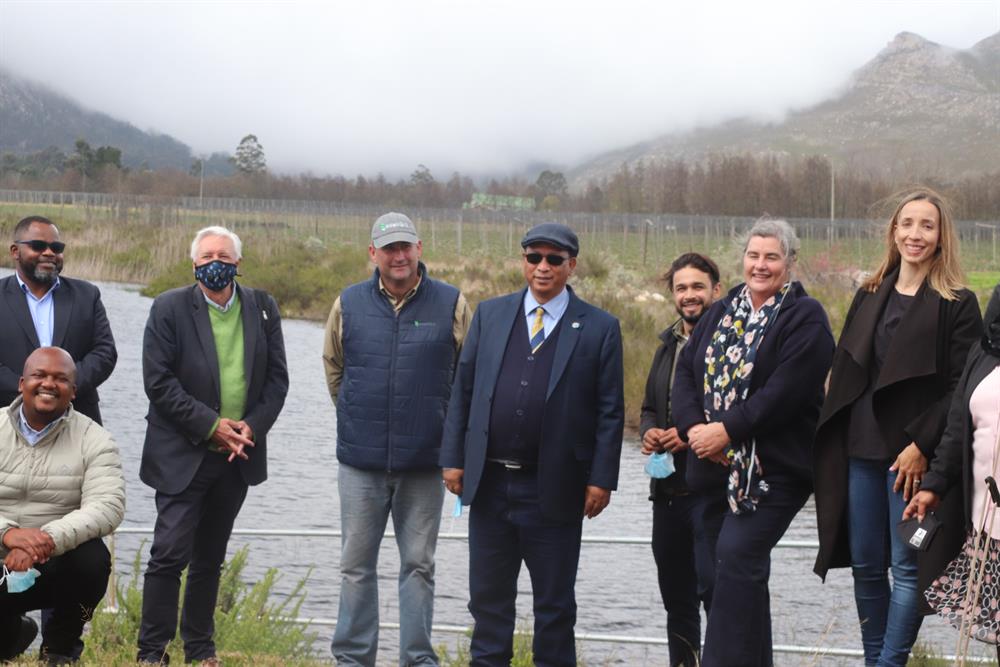GEORGE NEWS - An initiative to replenish and preserve water in the water catchment area of Herold and Waboomskraal has saved an estimated nine billion litres of water per year over the past 10 years.
This is owing to the George Ecosystem Restoration for Watershed Health and Replenishment initiative, a collaborative effort between South African Breweries (SAB) and the World Wide Fund for Nature South Africa (WWF).
SAB and the WWF have been partnering over the past decade in implementing a seven-step process to address water security in this high-risk area.
In light of this, George Mayor Leon van Wyk and Western Agriculture MEC Dr Ivan Meyer visited the site of the George Ecosystem Restoration for Watershed Health & Replenishment initiative to observe the progress of the project.
Unique area suitable for hops
During the visit, SAB director of agricultural development Josh Hammann explained that the Southwestern Cape / George area is currently the only region on the continent that is suitable for growing hops, a vital ingredient in the water-intensive process of brewing beer. This is due to the area's unique geographical and hydrological features.
Clearing of alien vegetation
"The effects of climate change, including changing rainfall patterns, fluctuating and rising temperatures, and a growing demand from agriculture and urban development are putting increased pressure on water availability in the George region," Hammann said.
"The Watershed Health and Replenishment initiative focuses on convening stakeholders, identifying specific local water challenges and potential solutions, implementing agreed solutions with governance and financing mechanisms in place, communicating progress, and measuring impact." The massive water saving achieved was based on total clearing of invasive alien vegetation.
Active restoration
The project also involves active restoration. "New restoration techniques piloted on 20 hectares of riparian land proved that the local fynbos naturally restores itself when enabled to do so. The project also had a community impact with an estimated 36 000 person-days of employment created."
Hammann said SAB's goal is that by 2025, 100% of their communities in high-stress areas will have measurably improved water availability and quality.
In addition to the threat that climate change poses to the water supply in George, non-native vegetation in the Waboomskraal and Herold catchments are a major challenge to water security in the region.
Several options were considered to improve water availability in the local context, such as shifting on-farm water use practices and improving infrastructure by fixing leaks and desilting dams. While these strategies are important, the team focused on removing invasive non-native vegetation because of the significant benefit it could have for businesses, local communities and ecosystems.
Employment and training
"We know there is no single, one-size-fits-all solution to building water resilience and security," said Hamman. "Our solution is multi-faceted because the problem is multi-faceted. There is a significant social imperative that we aim to tackle with our watershed management process, and this includes job creation for the surrounding communities. In addition to implementing green infrastructure, this project has employed, trained and equipped local people and farmers to protect, conserve, and steward their watershed."
Hamman said they aim to optimise water use efficiency for hop farms, thus helping to build a more climate-resilient future for the region.
 From left are Deon Barnard (private hop grower), Mitchel Pretorius (SAB Bunsleigh farm manager), Neljanine Arendse (SAB Heidekruin farm manager), Tim McDonald (director of South African Hop Growers Association / private grower), Dean Searle (senior farm manager - SAB) and Pieter Terblanche (private hop grower).
From left are Deon Barnard (private hop grower), Mitchel Pretorius (SAB Bunsleigh farm manager), Neljanine Arendse (SAB Heidekruin farm manager), Tim McDonald (director of South African Hop Growers Association / private grower), Dean Searle (senior farm manager - SAB) and Pieter Terblanche (private hop grower).
Measurable impact
The impact of this initiative is measurable. A substantial amount of invasive species was cleared from the area, covering 1 275 hectares of initial cleaning as well as 200 hectares with two initial clearings due to fire regrowth, and 1 550 hectares of follow-up clearing, since some hectares of initial clearing have undergone more than one follow-up cleaning.
Samir Randera-Rees, programme manager for Water Source Areas with WWF South Africa, commended SAB for its commitment to understanding and managing water risks in their supply chain.
"The work we have done together has helped us develop a model for collaborative solutions in our catchments that deliver water replenishment and create employment and small business opportunities. Investing in ecological infrastructure is critical in securing a water future for South Africa and this is indeed a great milestone to celebrate," he said.

'We bring you the latest George, Garden Route news'
















